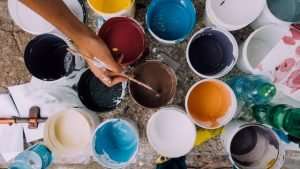People are always asking me how I got started, and how I keep going. How do you make art for a living? I have no idea! Every time I think about quitting, something good happens and I keep going.
I’ve been drawing since I was a kid. I loved it, but never thought of it as a career. It was something fun to do in my spare time—like playing video games or hanging out with friends. But then last year, things started to change….
You probably know that making art is difficult. The most popular art pieces online get millions of views. If your goal is to be popular, you don’t need to draw a lot of attention to yourself. Just put together a few entertaining videos or write some snarky tweets and sit back and collect the ad revenue.
But if you want to make a living at it then there’s this thing called rejection that comes into play, which is why even the best artists struggle with it. I don’t mean “struggle” in the sense that they’re upset about it or even aware that it’s happening—I mean struggle as in they go through periods where they can’t seem to catch a break…
As an artist, I’ve been rejected my share of times. I’m sure you have too. It happens to the best of us. But it’s not because we aren’t talented or good enough. It’s because, as a species, we are hardwired to reject new concepts and ideas that are different from our current understanding of reality.
We already have a lens through which we view the world (whether you call it a worldview or a paradigm). We tend to filter all our new experiences through that lens, rejecting what doesn’t fit. This is why people tend to “see” what they want to see in situations and circumstances rather than what actually is there.
The problem is that this filtering mechanism is not very accurate—we often end up believing things about the world which are not true. If you look at the history of science, this was the case with many “accepted truths” until one person decided to reexamine them again with an open mind and shared their findings with others who were willing to examine them with an open mind as well.
The human mind likes order and familiarity, but sometimes we need to get out of our comfort zone and try something new in
“ I’ve been drawing for about 15 years. Over the past few years, I’ve been trying to get better at it and that’s resulted in some of my work being shown in galleries. I’ve had a few pieces sell but overall, sales have been pretty low.
I’ve also sent out a lot of resumes and have gotten plenty of rejections. So I thought it would be fun to do a comic about the similarities between art and job hunting.
Here are some of the jobs I applied for:
– Comic Book Store Manager
– Junior Copywriter (a position which was later called ‘junior designer’)
– Graphic Designer
I got an interview for two of these positions at a comic book store and a design studio, respectively. At both interviews, they said they were impressed by my portfolio but they couldn’t offer me the position. In both cases, they were looking to hire someone with more experience. Since then, I haven’t gotten any more calls or emails from them (although I did get a rejection letter from the copywriting company).**
The inevitable stress and self-doubt that accompany the creative process can be daunting, but there are a few things you can do to put yourself in the right frame of mind.
Trying to get published is not just a numbers game, it’s also not a matter of having talent or not. It’s about having the right talent for the right people at the right time. And that’s where we come in.
At Asimov’s Science Fiction, we have a long history of introducing authors to our readers that have been rejected by other markets or who may not have even considered submitting their work before. We believe that good writing is good writing, no matter where it comes from. If your story is good enough for us, chances are it’s good enough for someone else.
And yes, even if you are already published in other markets or have already won awards, even if you are one of those lucky few who seem to come out of nowhere and land with a splash on the scene: we want to see your work! Chances are high that we will be able to find a place for it.*
There are many reasons why you might struggle with your art. It’s not just that it is hard to do, but it’s also hard to get people to see and appreciate.
An artist who is also a scientist once told me he was working on an extremely difficult experiment in his lab. He said that he would routinely have to try over 100 different conditions before achieving the desired result. And even then, he didn’t know if he could be sure that some other condition wouldn’t produce the same result. He said to me, “It is so much easier to succeed when you don’t need anybody else for your success.”
He was explaining how the scientific method helped him in his work, since it allowed him to eliminate variables and make sure that he knew what was causing the changes in his experiment. But I think that this applies equally well to artists who rely on their own work: they will have more consistent success if they can rely on themselves for the success of their art rather than hoping others will want it too.

